Following the release of the first science images from the telescope, ESR looks back in time more than a decade to recall our contributions to JWST mechanism developments, applying the expertise of ESTL (European Space Tribology Laboratory). ESTL has played an important role to allow JWST’s instrument teams to reach their lifetime goals, overcoming mechanism challenges in both the NIRISS and NIRSpec instruments, as well providing lubrication of components for the Fine Guidance Sensor.
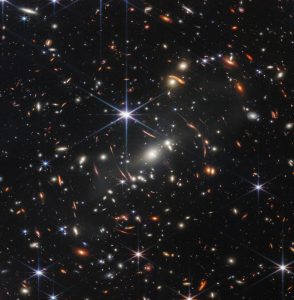
It has been estimated by NASA that over 20,000 scientists and engineers have worked on JWST for over 2 decades to create this unprecedented capability. Many challenges have been overcome, including how to ensure reliable operation of mechanisms at cryogenic temperatures, with some being well publicised, such as sunshield deployment operations and primary mirror positioning, needed to bring the telescope into service. However, some of the more challenging requirements for mechanisms have involved the science instrument payloads that will need to function much longer in harsh conditions at cryogenic temperatures, over more than 5 years of mission lifetime, to ensure that the science objectives of the mission can be achieved. Precise and reliable movement within these assemblies is key to enable functions related to calibration, focusing and optical filtering that shows such promise to peer through cosmic dust, unlock secrets of Earth-like worlds and understand the universe through unprecedented resolution in the Infra-red spectrum made possible with a cryogenic instrument operating in deep-space.
NIRISS was the first of the JWST instruments to complete in-orbit commissioning. NIRISS stands for Near InfraRed Imager and Slitless Spectrograph. It has a wavelength range of 0.6 to 5.0 μm and provides observing modes for slitless spectroscopy, high-contrast interferometric imaging, and imaging at wavelengths between 0.6 and 5.0 μm over a 4.8-square-arcminute field of view. The instrument was designed with the capability to study transiting exoplanets, detecting constituents of the distant planetary atmospheres. ESTL has provided tribology investigation support and component lubrication for the Dual Wheel Filter Mechanism main bearings and geared motors within NIRISS.
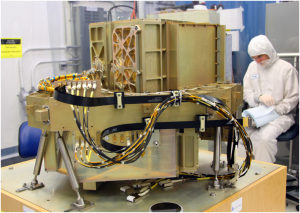
NIRSpec, or the Near InfraRed Spectrograph has also been declared ‘ready for science’ and will enable scientists to obtain simultaneous spectra of more than 100 objects in a 9-square-arcminute field of view. It provides medium-resolution IR spectroscopy over a wavelength range of 1 to 5 μm (and lower-resolution spectroscopy from 0.6 – 5 μm). ESTL provided support and component lubrication for the geared motor in the refocussing mechanism assembly.
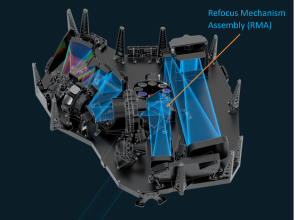
Essentially, there were critical points reached in the development of both NIRISS and NIRSpec instruments, where lifetime limitations of motors were discovered for operation at cryogenic temperatures below 40K (-233degC). In the case of both NIRISS and NIRSpec, the instrument teams sought the support of ESTL to investigate motor lifetime concerns and received support for their recovery and ultimately re-qualification.
In late 2008, ESTL was engaged by Airbus (formerly Astrium Gmbh) to support a post-life investigation into the lifetime of a motor with a three-stage planetary gear within the Refocussing Mechanism for NIRSpec. The investigation and support work (funded by ESA) was previously described in a paper by Airbus D&S (Friedrichshafen), where the requirement had been to achieve > 400,000 motor actuations at cryogenic temperatures. Post-life test inspections indicated some serious degradation on both bearings and gears. ESTL supported Airbus through trade-offs, working with the motor supplier Phytron Gmbh. Work included verification of alternative materials for planetary pin bushings and bearing cages, as well as improvement of bearing and gear lubrication. MoS₂ and lead lubrication were tested for gears, with MoS₂ showing a minor advantage in terms of lifetime. Finally, polyimide bushings were selected for planetary pin supports and implemented with sputtered MoS₂ lubrication applied to bearings and gears, along with implementation of redesigned PGM-HT bearing cages.
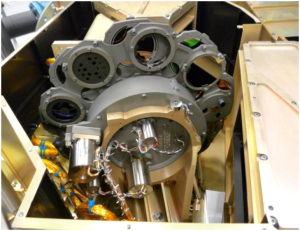
In 2011, ESTL was engaged by the Com Dev-Honeywell (funded by the Canadian Space Agency) to support a post-life investigation into the lifetime of a motor in the Dual Wheel Filter mechanism, with a single-stage planetary gear, where life-testing had only achieved slightly more than 50% of the required actuations. The challenge to recover was made more difficult as, during the contract, the the lifetime requirement for the wheels was increased by a further 3x. This was due to as the instrument undergoing a rapid transformation to a spectrograph type instrument from what was formerly called the Tunable Filter Instrument, becoming the NIRISS instrument, where the spectrograph is enabled using multiple ‘grisms’ and other filter mounted to achieve various combinations in the dual filter wheel arrangement). ESTL provided key assistance in the root cause failure analysis and resolution in terms of tribological consultancy, working collaboratively with Com Dev-Honeywell, CDA Intercorp, CSA and NASA experts, as documented in a paper by CSA in 2013, which explains the role of planetary pin supports in the failure at cryogenic temperatures. Bushing materials were considered to replace pin supports, but deep groove bearings were deemed a superior solution and implemented. The existing lubrication for motor and gearhead bearings and gears was changed to ESTL’s sputtered MoS₂. The motor and gearhead were then verified to achieve > 1.3 million motor revolutions at 35K, with the output stage completing over 140,000 revolutions, as described by Aldridge (paper in 2015).
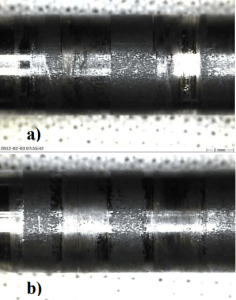
It is notable that issues with respect to wear at planetary pin supports were common issues to designs of both motors for cryogenic operation, which had been based on existing supplier designs, where thermal expansion and material selection had been factors in the degradation. Similarly, concerns for motor bearing lifetimes were in part addressed for both solutions, using ESTL’s heritage cage designs utilising PGM-HT material, where ESTL led early studies of PGM-HT (2001 paper).
Prior to the consultancy activities described above, ESTL was to provide lubrication solutions for the main wheel bearings of the Dual Wheel for NIRISS (paper by Leckie in 2010) and for the linear wheel to rail guide mechanism for the Fine Guidance Sensor focus mechanisms. These features were described by CSA (ESMATS paper from 2013). The Webb instrument experience has demonstrated the importance of tribology to enable instruments at these extreme temperature by giving certainty of reliable operation from ambient to < 40K. Establishing controlled deposition and/or release of MoS₂ from self-lubricating polymers has been a key enabler for so many of the JWST instrument functions.
For more information regarding fundamental tribology research or for mechanism solutions in extreme environments / challenging lifetimes, see: